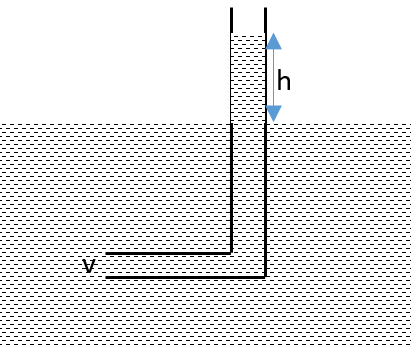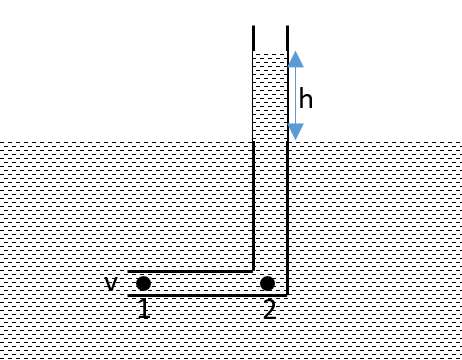
An L-shaped glass tube is just immersed in flowing water such that its opening is pointing against flowing water. If the speed of water current is v, then :

A. The water in the tube rises to height
B. The water in the tube rises to height
C. The water in the tube does not rise at all.
D. None of these.
Answer
141k+ views
Hint:When the pressure is equal then fluid does not flow as the fluid flows in the direction of the higher pressure to the lower pressure. The fluid in the tube is at rest. So the pressure inside the tube should be equal.
Formula used:
where P is the pressure due to fluid density
Complete step by step solution:

Image: The L-shaped tube inside the flowing water
We take two points, point 1 outside the tube and point 2 inside the tube but on the same horizontal level. The water at point 1 is flowing at the speed of v and the water at point 2 is at rest.
Let the pressure at point 1 is
The density of the water is
Applying Bernoulli’s equation between the two considered points 1 and 2, we get
As two points are on the same horizontal line,
On simplifying, we get
Therefore, the correct option is A.
Note: We must be careful when choosing two points to apply Bernoulli's theorem. One point should be outside the tube and the other should be inside the tube. If we take both the points inside the tube then there will be variation of pressure and due to which the fluid in the tube will start flowing and the height of the fluid in the tube will not be static.
Formula used:
where P is the pressure due to fluid density
Complete step by step solution:

Image: The L-shaped tube inside the flowing water
We take two points, point 1 outside the tube and point 2 inside the tube but on the same horizontal level. The water at point 1 is flowing at the speed of v and the water at point 2 is at rest.
Let the pressure at point 1 is
The density of the water is
Applying Bernoulli’s equation between the two considered points 1 and 2, we get
As two points are on the same horizontal line,
On simplifying, we get
Therefore, the correct option is A.
Note: We must be careful when choosing two points to apply Bernoulli's theorem. One point should be outside the tube and the other should be inside the tube. If we take both the points inside the tube then there will be variation of pressure and due to which the fluid in the tube will start flowing and the height of the fluid in the tube will not be static.
Latest Vedantu courses for you
Grade 10 | MAHARASHTRABOARD | SCHOOL | English
Vedantu 10 Maharashtra Pro Lite (2025-26)
School Full course for MAHARASHTRABOARD students
₹33,300 per year
EMI starts from ₹2,775 per month
Recently Updated Pages
Difference Between Circuit Switching and Packet Switching

Difference Between Mass and Weight

JEE Main Participating Colleges 2024 - A Complete List of Top Colleges

JEE Main Maths Paper Pattern 2025 – Marking, Sections & Tips

Sign up for JEE Main 2025 Live Classes - Vedantu

JEE Main 2025 Helpline Numbers - Center Contact, Phone Number, Address

Trending doubts
JEE Main 2025 Session 2: Application Form (Out), Exam Dates (Released), Eligibility, & More

JEE Main Exam Marking Scheme: Detailed Breakdown of Marks and Negative Marking

JEE Main 2025: Derivation of Equation of Trajectory in Physics

Electric Field Due to Uniformly Charged Ring for JEE Main 2025 - Formula and Derivation

Learn About Angle Of Deviation In Prism: JEE Main Physics 2025

Degree of Dissociation and Its Formula With Solved Example for JEE

Other Pages
Units and Measurements Class 11 Notes: CBSE Physics Chapter 1

JEE Advanced Marks vs Ranks 2025: Understanding Category-wise Qualifying Marks and Previous Year Cut-offs

NCERT Solutions for Class 11 Physics Chapter 1 Units and Measurements

Motion in a Straight Line Class 11 Notes: CBSE Physics Chapter 2

Important Questions for CBSE Class 11 Physics Chapter 1 - Units and Measurement

NCERT Solutions for Class 11 Physics Chapter 2 Motion In A Straight Line




